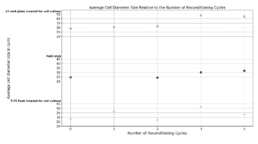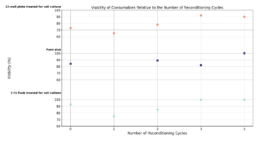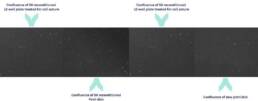
Cell passaging and seeding
This study evaluated the performance of various new and reconditioned laboratory consumables (up to five reconditioning cycles). Those consumables included T-75 flasks treated for cell culture, petri dishes*, and 12-well plates treated for cell culture. To compare new and reconditioned consumables, they were seeded with Rat-1 cells at a concentration of 10^4 cells/mL. Each consumable was tested in duplicate to account for any potential contamination.
During each reconditioning cycle, both new petri dishes and reconditioned consumables were seeded and incubated at 37.5°C. Reconditioned consumables were removed from the incubator after 2 days to assess cell confluence and morphology through photographs taken at different magnifications (10X and 20X) and to evaluate cell viability using an automated cell counter.
After collecting the data, the consumables were reconditioned using our process and then re-seeded. This process was repeated for up to five reconditioning cycles.
Comparisons were made between the confluence of reconditioned consumables and new petri dishes seeded at the same time. Average cell diameter was measured for the various reconditioned consumables and compared across all reconditioning cycles. The same was done for the viability of the cells.
This experiment allowed us to assess the performance of reconditioned consumables and analyse the effects of reconditioning on cell growth.
* No data collected during the first reconditioning.




Results
Reconditioned consumables generally achieved comparable cell confluence compared to new petri dishes seeded on the same day. Additionally, no clear trend or strict decrease in cell size was observed between new and reconditioned consumables across the reconditioning cycles. Although cell viability fluctuated through the reconditioning cycles, it did not show a consistent decline. These results indicate that the reconditioning process did not adversely affect the performance of the consumables.

Conclusion
Our process operated in a way that allows the use of consumables that are reconditioned up to five times for cell passaging and seeding.
This conclusion applies to consumables with a chemical surface treatment, excluding those with a biological surface treatment, such as collagen-coated consumables.
